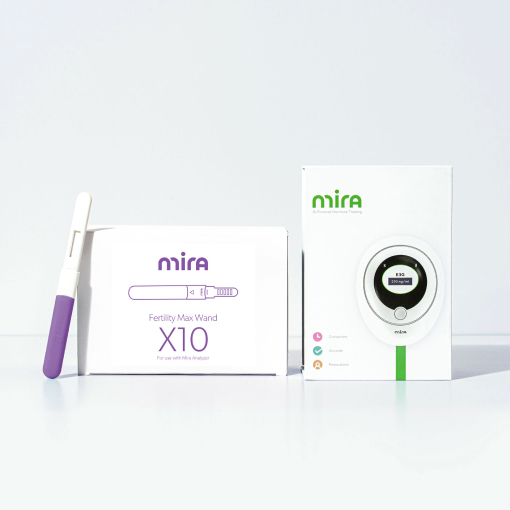What Implantation Cramps Feel Like & How Long They Last
When you’re trying to conceive (TTC), you might find yourself paying more attention to your body than usual, scanning for signs of early pregnancy.

While it’s unlikely that every small twinge is a sign of pregnancy, some women do experience cramping when the fertilized embryo implants in the uterus. These so-called implantation cramps affect about 30% of women in the early stages of pregnancy, and may or may not be accompanied by other symptoms.
It can be challenging to tell the difference between early pregnancy symptoms and PMS symptoms — and implantation cramps are no different. After all, many women experience cramps days before their monthly period is due.
So, what makes implantation cramps different, and how soon can you take a pregnancy test to confirm you are pregnant? In this post we will explore what implantation cramps feel like, how long they last, and when to take that test.
What Is Implantation?
Implantation refers to the early stage of pregnancy when the fertilized egg travels down the fallopian tube and implants in the uterine lining, or endometrium. This stage is especially important because the developing fetus derives nutrients from the endometrium to help it grow.
Some women experience symptoms during implantation, while others may feel no signs at all. The symptoms of implantation can include light brown or red discharge and implantation cramps. We’ll talk about implantation cramps in greater depth in the next section.
What Is Implantation Cramping?
One of the symptoms you may experience during implantation is cramping. These cramps can feel similar to your monthly PMS cramps, so it’s important to understand the difference between them, including what implantation cramps feel like and how long they last.
When Does Cramping Occur?
To understand when implantation cramps occur, it’s important to understand how fertilization works:
When you ovulate, sperm joins the egg during the stage called conception. Conception occurs while the egg is still in the fallopian tube. After conception, these combined cells begin to multiply, forming a blastocyst. The blastocyst then needs to travel down the fallopian tube into the uterus, before joining with the uterine lining during implantation. Implantation triggers the release of the pregnancy hormone hCG, which gradually rises until it is able to be detected on a pregnancy test — approximately 14 days past ovulation (DPO).
As you might expect, this complex process can take several days. Implantation takes between 6-12 days, most often occurring 8-9 days after conception. When it occurs after 10 DPO, it is known as late implantation. You may feel cramps and other symptoms of implantation around this time, so pay attention to your body at 6 DPO and beyond to observe for signs of implantation.
Where Do You Feel Implantation Cramps?
Implantation cramps, like period cramps, originate in the uterus. You will probably feel them in the same place where you feel your monthly period cramps — which can be confusing.
You might find yourself wondering whether you have period cramps or implantation cramps, especially if you also experience implantation bleeding. Pay attention to the timing of the cramps to differentiate them from period cramps: while implantation cramps most often occur between 6-12 DPO, you will likely not feel period cramps until 14 DPO or beyond.
Most women feel these cramps in their lower abdomen. However, if you have what’s called a retroverted or retroflexed uterus, you may feel cramps in your lower back instead. Your period cramps may feel different if you have a retroverted or retroflexed uterus because the uterus faces the opposite direction from normal. A retroverted or retroflexed uterus is nothing to worry about: it’s considered a variation in biology as normal as variations in eye color.
What Do Implantation Cramps Feel Like?
Women describe implantation cramps as a mild to moderate tingling, pricking, or pulling sensation. They may feel similar to your normal period cramps, but they will probably be milder and should not be intense or severe. A woman who experiences extremely painful cramps at 6-12 DPO should consult with her OB/GYN as these cramps could be a sign of a medical condition, such as endometriosis, or a miscarriage.
You may be more likely to be pregnant if you experience other symptoms of early pregnancy alongside implantation cramps. Some signs and symptoms of early pregnancy to look out for between 6-12 DPO include:
- “Morning” sickness (this can occur at any time of day)
- Swollen or tender breasts
- Darkening of the nipples
- Fatigue
- Food cravings or aversions
- Heightened sense of smell
These changes occur due to rising levels of the pregnancy hormone hCG. As hCG continues to rise, you may find that these symptoms become more pronounced over time. However, you’ve probably also noticed that these symptoms are similar to those of PMS.

Paying attention to your exact fertility hormone concentrations using the Mira Fertility Tracker can help you pinpoint hormonal changes with greater accuracy to differentiate early pregnancy symptoms from PMS.
How Long Do Implantation Cramps Last?
Implantation occurs around 6-12 DPO and symptoms of implantation, such as spotting and cramping, also occur around this time. Implantation cramps usually last a few days but may last as long as one week.
Most women experience implantation around day 25 of their cycle. Using this example, you could experience implantation cramps from day 25 through day 32 of your cycle. Depending on the length of your typical menstrual cycle, this means you could continue to experience symptoms of implantation even after you’re able to take a pregnancy test to confirm whether or not you have conceived successfully.
How Can You Treat Cramping Caused By Implantation?
Implantation cramps should not be so severe that they disable you or interfere with your daily activities. That being said, they can still be annoying and painful! If implantation cramps bother you, there are a few options for dealing with them.
Generally speaking, you can treat cramping caused by implantation in the same way you tend to period cramps: try using a heating pad or, if that does not provide enough relief, taking an over-the-counter pain reliever like Tylenol (acetaminophen). There is also some evidence that exercise can help: the endorphins from exercise may work as a natural pain-reliever.
What Else Could It Be?
When you’re TTC, it’s natural to hope for news worth celebrating — but experiencing cramps around 6-12 DPO does not necessarily mean you are pregnant. Sometimes, these cramps could be a sign of something else.
Most commonly, implantation cramps are confused with PMS cramps. These cramps occur around the same point in your menstrual cycle and feel similarly, though implantation cramps might be less intense. You might also confuse implantation cramps for period cramps and if your period arrives early, you might mistake it for implantation bleeding and assume your cramps are also due to implantation.
Implantation cramps can be uncomfortable, but implantation should not cause severely painful cramping. If you are experiencing intense cramps at 6-12 DPO, you should contact your OB/GYN. It may be a sign of a health condition such as endometriosis, which can cause chronic pelvic pain. It could also be a sign of an early miscarriage, especially if you experience bleeding alongside intense cramping.
The best way to differentiate between implantation cramps and cramps due to other causes is, unfortunately, to wait. The two-week wait (TWW) is famous for being challenging, but there is no way around it: you cannot take a pregnancy test before 14 DPO (or the first day of your next expected period) if you are looking for the most accurate results.
What About Pregnancy Testing?
If you are hoping to take a pregnancy test while experiencing potential implantation cramps, you may be disappointed to hear that pregnancy testing before 14 DPO (or the first day of your next expected period) is less accurate. Sadly, you are more likely to get a false-positive or false-negative result if you test before 14 DPO.
False-positive results can be due to a chemical pregnancy, which is actually a type of early miscarriage. When you receive a positive test due to a chemical pregnancy, it will most likely come out negative when you take a test again after 14 DPO.
False-negative results are also common before 14 DPO, since hCG may not have risen high enough yet for the pregnancy test to detect it in your urine. So, stick out the TWW in order to get the most accurate results from your pregnancy test!
Since implantation cramps occur between 6-12 DPO, it’s still a little too early to take a pregnancy test, even if you are experiencing other signs of early pregnancy. However, if you truly cannot wait any longer, you can make an appointment with your OB/GYN for a blood test.
A blood test can detect hCG faster than a home pregnancy test and may be able to detect pregnancy as soon as 6-8 days after conception. Still, you should be aware that many OB/GYNs will not perform the test until after the first day of your next expected period has passed.
Recommended for you
Navigate your fertility with peace of mind
Mira’s Editorial Process
All content produced by Mira meets stringent editorial standards, ensuring excellence and accuracy in language and medical precision. Every piece undergoes thorough fact-checking and review by qualified professionals. Check out our full editorial process to learn more.














